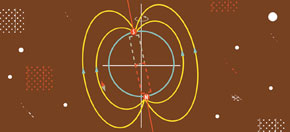 Daniel Bueno
Daniel Bueno
For many years, the general belief was that the geographic north and the magnetic north were the same. In 1831, British explorer James Ross observed that they were not the same when, upon reaching the North Pole, he noticed that the compass pointed downwards, i.e., to the magnetic north (the lines of force were vertical and the needle only remained still when it was in the vertical position).
The geographic north results from the Earth’s rotating movement, while the magnetic north is due to the magnetic field generated by the movement of the molten metal of the external core around the Earth’s solid metallic core. Therefore, each north expresses a different geophysical phenomenon. The Chinese invented the compass and the Europeans embarked on sea voyages based on these principles.
A magnetic needle always points in the direction of the magnetic north pole and only approximately to the geographic north. The angle between the magnetic north and the geographic north reflects the magnetic declination of the place and generally ranges from 20 to 30 degrees. As the magnetic field varies with climate events, in São Paulo the current difference between the true north and the magnetic north is 23 degrees.
The nomenclature of the poles often causes confusion. According to the conventions of physics, the north magnetic pole lies in the southern part of the Earth and vice versa. To avoid this confusion, it was agreed that the north magnetic pole would be the pole closest to the geographic North Pole. The same convention holds true for the South Pole.
Eder Molina, of the University of São Paulo (USP)
Republish